Adrenaline-packed flushes in the rocky world of the chukar.
By Lindsay R. Mohlere
Shake Simpson plopped down on a flat rock outcrop and unlaced his boots. Below him, the Grande Ronde River cut through the mountain foothills of Washington State, carving a deep canyon with serious ravines etched from the river's edge to the ridge tops.
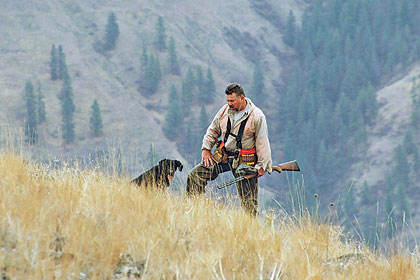 Jim Shuttleworth and Kate take a breather during the three-hour hike to the ridge top. |
Speckled with fir pockets and basalt extrusions, the plateau on top was covered in blonde and mottled green grasses blowing softly in the wind.
"If I ever see that guy again, I'll wring his neck like a wounded rooster," Shake said, groaning to remove his boots. "I'm getting too old for this..."
Shake, Jim Shuttleworth and I, and our two dogs, had finally crested the ridge after a three-hour vertical forced march about a mile uphill. The object of the ascent was to hunt chukar partridge. It had been an ordeal born out of zealotry; a tough climb for young legs, but for our over-50 crowd it was torture.
Sprawled out in the knee-high cheat grass, Shake retied his boots and spit angry words between deep breaths. "Stiffed by a guide. Never had the door slam that hard."
The dogs, Shuttleworth's four-year-old black Labrador, Kate, and Molly, my German wirehaired pointer, were unfazed by our huffing and puffing. Kate stretched and curled next to Shuttleworth and offered a fitting comment on our puny physical endurance with a yawn.
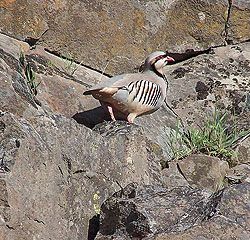 A chukar stands guard on the rocks above the Grande. |
Loaded with dual canteens each, munchies, ammo and shotguns, we found it necessary to keep the dogs leashed rather than let them dictate the pace. We wanted fresh dogs for the hunt. No doubt, we would have been left behind by the way they both strained at the leads and resisted our many rest stops. They were ready to go, even if the hunters were close to cardiac arrest.
Earlier, we met our guide in the half-light of dawn. The meeting went from jovial excitement to near violence in the blink of an eye when he abruptly cancelled out, leaving us stranded like an ugly blind date. On the Grande, being without a guide is a definite problem. Most of the land along the river is private range. It's steep, uphill country, with deep ravines and vertical canyon walls; slippery basalt screes with open pastures of grass terraced to cliff edges that cut straight down toward the river.
Ranching roads can get you to the top of the ridges; your boots get you to the bottom. A guide with private road access rights can drive to the ridge tops and stage hunts from the top down, the perfect chukar set-up. Without a guide, it's hard to find a place to hunt and a long, difficult climb to the top.
Once our erstwhile guide gave us back our deposit, he tried to right the situation by telling us to go to the switchback off the main road and hike to the top of a ridge that dropped back towards the river.
"It's public land on the way up and private on top, but nobody hunts it. You'll find a lot of birds up there," he said. "Just wait 'til you get to the top before you start hunting."
Without any other brilliant plans, we took the challenge and loaded up the dogs for the short drive to the bottom of the ridge. It was 8 a.m. and the early November sun was beginning to sneak over the mountains to the east, painting the wispy clouds crimson.
From our temporary roost overlooking the river, I finally caught my breath and wondered if my wobbly legs could stand another three or four hours of hiking over the top and then down the steep finger of the ridge. The climb up had taken a heavy toll. It again proved chukar hunting is not for the sound of mind. Like all chukar hunting, there's the chance it would be one of those punishing days slipping on loose rock and fruitless hill climbing just to see the sights.
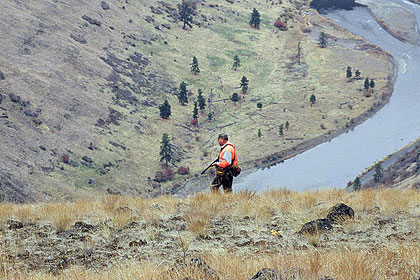 It's a long way to the bottom from the ridge top above the Grande Ronde River. |
Then we heard the laughter. The "chuck, chuck, chuck" call of a chukar taunted us with a dare to come and get them.
Out west, for the upland bird hunter with good physical stamina and much less sense, the hedge against diminished pheasant and quail populations, limited public hunting land and expensive private land is the chukar partridge. Called "chuks", "devil birds" or several other more colorful but less printable names, the chukar lives in a rocky vertical world.
It is country is where no one wants to go, but the promise of coveys exploding underfoot and throat clenching adrenalin rushes make grown men do strange things. It's a curse and it makes you climb. The birds move on foot in coveys up and down the slopes. When flushed, it only takes an instant before they reach Mach 1 and then they angle downhill close to anything that obscures sight.
It's like shooting buzzing honeybees equipped with afterburners. To ensure reasonable success, hunters start from the top, criss-crossing down or side-hill along the slopes.
Chukar hunting is the extreme Stairmaster of bird hunting, complete with stunning vistas, aching ankles and furious shooting. (Note: shooting, not hitting.)
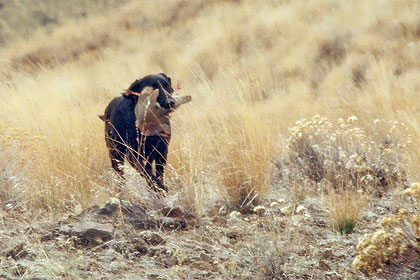 Kate retrieves a Grande Ronde chukar. |
If you are hunting without a dog, good luck. Chukars are sneaky little demons and will flush way ahead or run wild up the slopes. Without a four-legged partner to warn you of the looming ambush or give chase to block the sprint, you're most likely up the creek. A dog will cover more ground than you can possibly handle and retrieve where humans do not belong.
Molly and Kate paced the circle like a pair of motivational speakers. They were charged and ready to run. Ignoring the obvious, we stayed on th
e ground stretching and moaning, munching on power bars until our heart rates settled and our legs felt whole.
After a final tightening of boots and a good cursing of our bogus guide's complete heritage, we decided to spread out and zigzag across the tabletop ridge. The wind was behind us, so we chose a route that would crosswind the walk to give the dogs a better chance of catching scent. It wasn't long before our efforts were rewarded.
A short distance from where we had huddled, Kate stuck her nose into a tangled wild rose bush, busting a covey of 10 or 15 chuks a few yards ahead. The covey took an immediate right turn and settled into a supersonic dive toward the bottom of the canyon, following the line of our ascent. The shooting started a few heartbeats too late. The little brown devil birds had faked us out.
"Hike all morning uphill and then this€¦try to shoot those *******s with talcum powder," growled Shuttleworth, who was then ribbed by Shake. "At least you had rounds in the chamber. I forgot to load up after the climb," he said.
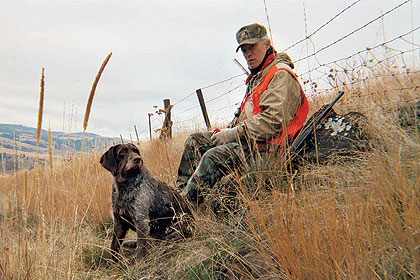 Molly takes a break to rest her hunter, the author. |
It took a few minutes to regain our composure. That many close-flushing birds tend to ramp up the blood pressure. The birds had taken a quick exit and chasing them down was not an option. In some cases, a hunter will follow a covey, but not on this trip. It was too steep and the day was burning fast. A steady meander across the plateau was the order of the day.
Again we spread out and moved with the wind beside us. For the next three hours we negotiated through rock outcrops, grass patches and small swales over the ridge top, slowly coming together as the ridgeline began to angle toward the point of sloping downward.
Molly worked the outer perimeter, quartering across, while Kate made straight casts backing her and closing to flush when she hit a point. There were a few instances when each dog tackled a separate covey at the same time, which caused some wild shooting and exuberant cussing.
At one point, with the wind to my back, Molly ran through a covey without flushing them. She missed the scent cone and the birds skittered about making the ground seem like it was alive. At the instant I recognized what had happened, the dog turned a four-wheel drift stop into a U-turn and hit a solid point.
I made three steps toward her and the grass erupted. I didn't know whether to run, spit or go naked. I pulled the trigger on my old 1100 three times before I took the safety off. A Hail Mary brought one chuk down, bouncing through the weeds with Molly eagerly on its tail as it tumbled like a rubber ball.
The other birds made a low pass around a hillock and flew right into the blazing guns of Shake and Shuttle. Out of a possible 12 in the covey, we took five. It was an excellent return on shooting when it comes to chukar.
Throughout the day, the dogs worked as if they had trained together. Molly held staunch points and even retrieved to hand a couple of times. Kate, with her long legs and excellent conditioning, held her end up with bouncing flushes and single-minded retrieves.
I had arrived at the top of the ridge with 20 rounds of 20-gauge no. 6 shot, which was matched by the other two hunters, who also carried 20 gauge guns. I know I lost some rounds in the frantic moments between coveys busting and reloading to prepare for the lone straggler or two to break out just when you drop your guard.
After three hours of steady walking and shooting, I was down to three shells. I had four birds in my vest, which I consider a pretty good day of shooting. Together, the three of us had 11 birds, two tired dogs, aching feet and huge grins of satisfaction.
When the ridge began to tail off to a hog's back, we reined in the dogs and broke off the hunt about 100 yards from the edges to prevent the chance a dog in pursuit would misjudge the cliff and fall. We took a quick breather and marveled at a huge thunderhead rolling down from the north and an orange sun dropping through the clouds to the west.
It was a great day, but time to get off the hill.






